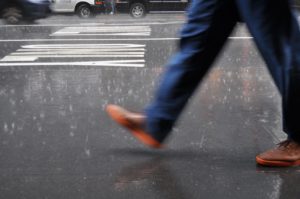Falling Forward

Photo by Mette Køstner on Unsplash
Apparently, all walking is merely falling forward and catching ourselves again and again. (Which means dancing is falling with rhythm, though that’s a different essay.) But truly that’s what we are doing when we are walking. If you Google ‘walking is falling’ there are numerous articles available of varying levels of complexity from all kinds of exercise science. The simplest explanation came from a group called Core Walking. “The way it works is pretty simple— moving through space with one foot in front of the other, as my legs switch there is a moment when the upper body is forward of the front leg. In that moment the brain registers that the body is about to fall and the brain tells the psoas major to initiate the pull of the back leg forward to prevent a crash.” Citation below.
This means we are quite literally falling all of the time. I find that oddly reassuring because mostly, I don’t end up on the floor. I’ve done my share of falling through the years. I was extraordinarily good at falling down the stairs in our home in my pre-teen years. I have a couple of mildly embarrassing stories like walking to class as a college freshman, stepping off a curb, and falling into the street for no reason whatsoever or sliding down three or four cement steps on my shins a few weeks into my new job at McMurry. I have a spectacular story of doing some sort of a flip into the air and landing flat on my back between rows of seats in the high school auditorium. Clearly, there have been times when I was falling better than walking. But like most of us, most of the time, my feet and my brain coordinate well enough that I don’t have to think about what an amazing balancing act simply walking is.
Yoga teacher and author Gary Kraftsow explains stability this way, “When we are standing the bodily base of support is our feet; when we are seated, the base is the buttocks and legs; and when we are lying down the base is the full length of the body. In general the larger the base, the greater the stability.” So when we do balance poses, the base becomes very small – one foot. And then we add motion to it. Talk about instability.
I think in our seemingly never-ending quest for balance we forget that we are actually quite good at balance all things considered. If we spent our lives sitting in one place, we stay pretty balanced, don’t we? Simple enough. But we aren’t generally satisfied with that idea. We get up and move, try new things, challenge ourselves. In other words, we shift from balance to imbalance on purpose! Which seems to me an interesting way of reframing this idea of balance.
Perhaps we aren’t simply looking for balance. Perhaps, instead, we are like the baby learning to walk, constantly testing out this balance thing as we attempt to explore our world. And it’s amazing when it works and a bit painful when it doesn’t. Like the toddler, we run into things, can’t get where we want to when we want to, and yes, we lose our balance and fall. But each time we try something new, we learn something. We develop new skills, new muscles, new ways of responding to the world around us. But to do this we have to go through a period of imbalance, instability to get there.
I wonder how our perspectives about what we are currently experiencing in the world would change if we understood the idea of balance this way. When we feel off-balance we have moved off our center or, as is currently the case we have been moved away from stability, and we have to then change something (move that back foot forward) to catch ourselves. What if life is, in fact, a series of moments of imbalance followed by balance each day, every day as we fall forward into something new. And sometimes that movement is painful, and we bump our noses or worse, give our heads a wallop as I did that day in the high school auditorium. Then the recovery time takes a bit longer, but we still recover. We still know how to move forward and to find a new form of balance.
In this view, our current circumstances are liminal space – that uncomfortable spot between the old and the not yet realized new. It’s that space between the first step and the one yet to come when we don’t yet know if we’ll be coordinated, fall, step on a rock, or move smoothly onto solid ground. But we move forward anyway, trusting that we are actually pretty good at this falling forward activity and we’ll figure it out as we go.
Take care,
Gage
Citations: https://corewalking.com/walking-is-falling/
Kraftsow, G. ( 1999). Yoga for Wellness. New York: Penguin Compass

Hi!
I was in today’s UTEP workshop and learned about this resource!
It was very refreshing to read this article after just reading so many Apocalyptic stories being posted everywhere.
Hi Liliana,
Glad to know you enjoyed it. I hope you enjoyed the workshop as well! I responded so quickly because I’m on the computer writing tomorrow’s blog post. You can always just come to the blog to see what’s happening or you can sign up for the newsletter to have it come to your inbox. Either way, I’m glad to hear today’s post was refreshing – that’s the yoga part. 🙂 Take care, Gage